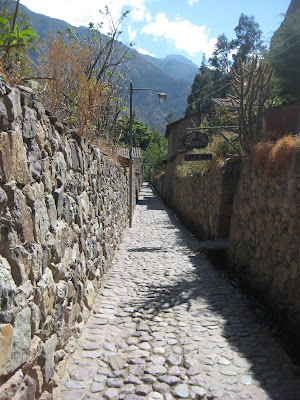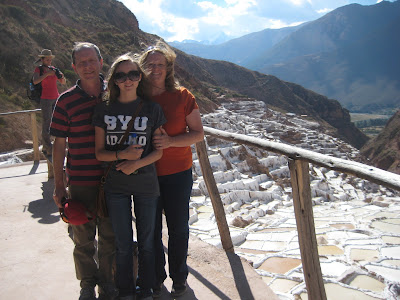The Sacred Valley of the Incas got it's name because it was the source of so much of the food that the Inca Empire used to feed it's people. We traveled from Ollantaytambo to Pisac and then back to Cusco on the day following our trip to Machu Picchu. We stopped at some amazing ruins an other sites along the way and because our taxi driver was also a history teacher, we had a guide along to share so many interesting facts an insights with us.
The ruins at Ollantaytambo were literally right outside the door of the hostel where we stayed. In fact, the hostel's walls were actually Inca stone. The city is known as the only living Inca city since it has been in constant activity since the times of the Incas.
Imagine this....Megan made a friend at the hostel.
The owner of our hostel was happy to show us some of the treasures that her family has found over the years as they have owned the home.
The Cathedral in Ollantaytambo just down from our hostel
There is still water flowing through the town in the same channels as it did hundreds of years ago.
Another look at the ruins
Ollantaytambo is the only fortress ruin where the Inca actually scored a victory over the conquering Spaniards. Their victory was short lived, however. They were eventually driven from the site.
Notice the ruins built into the mountain across the valley
Some of the fine stonework on the way up to the sacred part of the site
Looking down the valley from the ruins...
If you look closely, you can see terracing all through the valley.
The three of us in the sacred part of the ruins
More ruins up on the mountain
A close-up of the ruins from up a little higher....
...and then looking down at the city of Ollantaytambo.
More ruins.....
....more of the city
This is one of the streets of Ollantaytambo. You can see the Inca stonework and the water running through the city.
After leaving Ollantaytambo, we traveled through Urubamba and got this photo of Megan and Steve in front of the LDS chapel there

Next, we traveled to a site called Moray. This is supposedly a place where agricultural experimental planting took place. Because of the the different temperatures found at the levels of the terraces in the valley, different crops were grown here.
This gives some perspective as far as how big the ruins are. Those are people down there....
Meg with her Inca Kola along the journey
We next traveled to a place called Maras. This is a place where salt water comes from a spring and is channeled into these various pools on a hillside where it evaporates and is harvested as salt. The different colors represent different grades of the mineral.
Here we are at the Maras salt pools
A close- up of the salt deposits
The last site on our journey that day was Pisac. This is an amazing city and massive terraces which, according to our guide, would have rivaled Machu Picchu if the Spaniards had not found it and destroyed so much of it.
Some of the terraces at Pisac...
.....and even more terraces.....so extensive!!
Here are the terraces with part of the city in the background
Along the hillside behind the site were these many holes that we learned contained hundreds of mummies of Inca noblemen.
We returned to Cusco that night after a very full day of amazing ruins and stories. That night, we slept well and got ready for our bus ride to Puno the next day.



























No comments:
Post a Comment